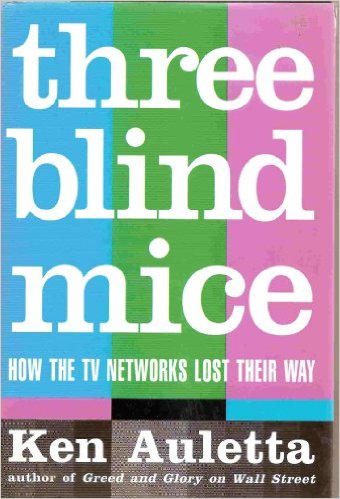Wednesday, June 22, 2016 is going down in history as a really big day in the world of television. The fact that C-SPAN aired cell phone video through the Periscope social media service for much of the day provided by Democratic members of Congress holding a sit-in in the U.S. House is nothing short of a siesmic change in our media world. This is the first of two blog posts looking at how television is changing.
Let me provide some context here.
 Journalist Ken Auletta, writing in his book Three Blind Mice, said that the television networks were facing an earthquake in slow motion in the late 1980s. There was the rise of cable, the growth of VCRs, the broth of new broadcast networks, and the realization by audience members that they ought to be able to control what they watched and when they watched it.
Journalist Ken Auletta, writing in his book Three Blind Mice, said that the television networks were facing an earthquake in slow motion in the late 1980s. There was the rise of cable, the growth of VCRs, the broth of new broadcast networks, and the realization by audience members that they ought to be able to control what they watched and when they watched it.
That earthquake continued to rattle on through the 1990s and the 2000ies with the growth of digital cable, direct broadcast satellite, DVDs and the digital video recorder.
And then, as I posted back in October of 2005, Apple set off what has turned out to be one of the biggest tremors in this ongoing quake. Apple announced a new version of the iPod music player that would now handle video files as well as music. Apple entering the video player market was a small thing. the big thing was that Apple was partnering with Disney to sell ABC Television’s top-rated TV shows through the iTunes media store. These programs were available the day after they aired on the network and cost $1.95 per episode without commercial interuption.
As I told my freshman class that morning, all mass media have both a hardware and a software component. There had been cool video hardware before, but there had not been such a revolutionary new source of programming for these devices that could be used by ordinary people. The fact that Disney was willing to sell their top television titles the day after they air on broadcast in a form that you can keep and replay as often as you wanted was a truly major change in the media world.
That revolution of consumer control over what, when and where they want to watch continued on with the rise of streaming services like Netflix, Hulu, and Amazon Prime.
While the click-wheel iPods with physical hard drives are now in the archives of history (though I happily still use my final edition iPod classic), watching video on our mobile devices is more popular than ever today. While our video world is quite different today, it does involve watching video that we have purchased online and either download or stream to the latest technological marvel.
At the end of my post nearly 11 years ago, I noted:
“Mark my words, Oct. 12, 2005, was a big day.”
I stand by that statement today, and I would argue that 11 years in the future, I will hold up the importance of Wednesday, June 22, 2016.

Pingback: Another Big Tremor in the Earthquake in Slow Motion: Part 2 – Two New Secrets | Living in a Media World